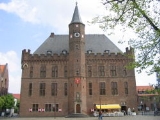
Kalkar
Encyclopedia
Kalkar is a municipality in the district of Kleve, in North Rhine-Westphalia
, Germany
. It is located near the Rhine, approx. 10 km south-east of Cleves. The most famous building of Kalkar is its church St. Nicolai, which has one of the most significant sacral inventory from the late Middle Ages in Europe.
died out in 1609, whereupon the city went over to the Margraviate of Brandenburg
. Marie of Burgundy, Duchess of Cleves
retired to Monreberg castle in Kalkar, where she founded a Dominican convent in 1455. Under her influence the city bloomed and artists were attracted to the favorable climate for cultural investment. She died at Monreberg castle in 1463.
Fast breeder-type Nuclear Reactor
. The plant has since been turned into Kern-Wasser Wunderland http://www.kernwasser-wunderland.de/, an amusement park with a rollercoaster and several other rides and restaurants.
North Rhine-Westphalia
North Rhine-Westphalia is the most populous state of Germany, with four of the country's ten largest cities. The state was formed in 1946 as a merger of the northern Rhineland and Westphalia, both formerly part of Prussia. Its capital is Düsseldorf. The state is currently run by a coalition of the...
, Germany
Germany
Germany , officially the Federal Republic of Germany , is a federal parliamentary republic in Europe. The country consists of 16 states while the capital and largest city is Berlin. Germany covers an area of 357,021 km2 and has a largely temperate seasonal climate...
. It is located near the Rhine, approx. 10 km south-east of Cleves. The most famous building of Kalkar is its church St. Nicolai, which has one of the most significant sacral inventory from the late Middle Ages in Europe.
History
Kalkar was founded by Dirk VI of Cleves in 1230 and received city rights in 1242. It was one of the seven "capitals" of Cleves (called Kleve), until the line of the Duchy of ClevesDuchy of Cleves
The Duchy of Cleves was a State of the Holy Roman Empire. It was situated in the northern Rhineland on both sides of the Lower Rhine, around its capital Cleves and the town of Wesel, bordering the lands of the Prince-Bishopric of Münster in the east and the Duchy of Brabant in the west...
died out in 1609, whereupon the city went over to the Margraviate of Brandenburg
Margraviate of Brandenburg
The Margraviate of Brandenburg was a major principality of the Holy Roman Empire from 1157 to 1806. Also known as the March of Brandenburg , it played a pivotal role in the history of Germany and Central Europe....
. Marie of Burgundy, Duchess of Cleves
Marie of Burgundy, Duchess of Cleves
Marie of Burgundy, Duchess of Cleves was the second child of John the Fearless and Margaret of Bavaria, and an elder sister of Philip the Good. Born in Dijon, she became the second wife of Adolph, Count of Mark in May 1415. He was made the 1st Duke of Cleves in 1417...
retired to Monreberg castle in Kalkar, where she founded a Dominican convent in 1455. Under her influence the city bloomed and artists were attracted to the favorable climate for cultural investment. She died at Monreberg castle in 1463.
Reactor
Kalkar is the site for the failed SNR-300SNR-300
The Fast Breeder nuclear reactor SNR-300 was built near the town of Kalkar, Germany The Fast Breeder nuclear reactor SNR-300 was built near the town of Kalkar, Germany The Fast Breeder nuclear reactor SNR-300 was built near the town of Kalkar, Germany (located in the federal state of North...
Fast breeder-type Nuclear Reactor
Nuclear reactor
A nuclear reactor is a device to initiate and control a sustained nuclear chain reaction. Most commonly they are used for generating electricity and for the propulsion of ships. Usually heat from nuclear fission is passed to a working fluid , which runs through turbines that power either ship's...
. The plant has since been turned into Kern-Wasser Wunderland http://www.kernwasser-wunderland.de/, an amusement park with a rollercoaster and several other rides and restaurants.

